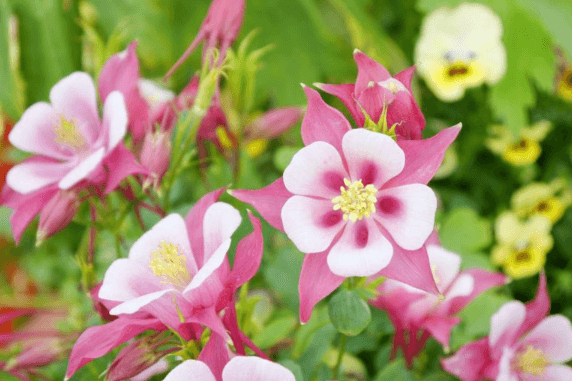
Columbine flowers (Aquilegia) are wildflowers with multi-colored petals that bloom from spring to early summer. It may look delicate but you should know that these flowers are the hardiest ones. If you are looking for flowers to plant in your garden, these are the best choices. But don’t know where to start. Well, here is your gardening guide! In this blog, let’s talk about how to plant and grow columbine flowers!
What are Columbine Flowers?
Columbine or Aquilegia is a perennial flower that adorns your gardens in the most delightful way. The airy foliage and colorful flowers are just what your landscape needs this spring/summer. Moreover, Aquilegia has around 70 species. Although short-lived, columbine flowers, these flowers perfectly fit the definition of enchanting.
Fun Fact!
The direct descendants of the earliest columbine flowers grow in the Colorado mountains and are deep blue in color.
You should know that the native columbine plants grow wild in mountain areas, along the stream beds, and in woodlands. Also known as granny’s bonnet, they may seem unusual but surely they are breathtaking.
How Do Columbine Flowers Look Like?
Well, columbines have small bell-shaped flowers with five petals and five spurs that extend backward. The petals of this flower are usually bi-colored and the color combinations are truly amazing. Furthermore, the colors include red with pink, lavender, blue, yellow, white, or any combo of these colors. What’s more, they cross-pollinate very easily. That’s why new species surface quite frequently. In fact, they attract pollinators like butterflies, bees, moths, and hummingbirds very easily because of their vibrant appearance.
How to Plant, Grow & Care for Columbines? Your Guide
Now that we know the basics of these flowers, let’s get to the main topic: how to grow them. To plant columbine flowers in your garden, you have to make sure the conditions are favorable. This includes light, soil, and humidity the plant needs to thrive. Here is your guide on adorning your garden with beautiful columbine flowers.
When to Plant Columbine?
The ideal time to plant the seeds of these flowers is fall or after the last spring’s frost. This allows them to go through stratification naturally during winter. As a result, the seeds can germinate without sprouting prematurely. Anyhow, you should:
- Directly sow the seeds in the ground when growing outdoors
- Sow seeds indoors 8-10 weeks before the last spring’s frost
- You can also plant seedlings after the last spring’s frost
What are the Conditions to Grow Columbine?
Planting columbine requires you to get all the relevant factors right. After all, they’re important for its smooth growth. So, let’s get into them:
1. Light
For optimal growth, columbines are best planted in partial shade. They struggle in hot, full sun but can tolerate full sun in cooler climates or during the cool spring days. After flowering, columbines benefit from some shade during the summer heat, as it helps them replenish their energy stores. Providing the right balance of sun and shade ensures these beautiful plants thrive – smoothly so! As a result, you have vibrant blooms. Besides, the right exposure helps maintain their lush foliage throughout the growing season.
2. Soil
For the proper growth of these alluring plants, choose well-drained, humusy soil with a neutral to slightly acidic pH. Before planting, enrich the soil with compost to provide essential organic material. Columbines prefer sandy or loamy soils over clay. After all, proper drainage is crucial for their health. This factor – the soil – is really important to create the ideal environment for columbines to flourish. It also helps maintain vitality during the growing season
3. Water
Columbine plants require moderate soil moisture. So, you have to avoid over-watering. In fact, water them when the top 1 to 2 inches of soil dries out. Besides, columbine plants are drought-tolerant perennials. Therefore, they need watering only once a week. Clearly, this means that these plants are very low-maintenance, making an ideal choice for gardening. Remember, along with proper watering, mulching is also an important step.
4. Temperature
Columbines are perennial in USDA hardiness zones 3 to 8. Make sure you select the variety suited to your specific climate. These plants flower best in cooler temperatures. It is because excessive heat can cause them to go dormant. Therefore, they are not the best choice for the summer season. In simple words, Cooler weather encourages more abundant blooms, while high temperatures reduce flowering.
5. Fertilizer
To ensure the healthy growth of flowers and foliage, use a water-soluble fertilizer monthly during the growing season. Pick a 5-10-5 NPK fertilizer as columbines require phosphorus for healthy root development. Moreover, fertilizing the soil in the right way is always a plus. After all, it ensures your plants are healthy, stunning, and lush throughout the season.
Columbine Flowers Plantation & Growth Guide
| Plantation season | Fall, After last spring’s frost |
|---|---|
| Blooming season | Spring, Early Summer |
| Sun Exposure | Partial Shade, Full Sun (in colder climates) |
| Soil Type | Well-drained, humusy |
| Soil Preparation | Add compost to the soil |
| Watering | Only when the soil dries out, Once a week |
| Temperature | Cooler climate |
Why Plant Columbine Flowers?
Columbines give you a lot of reasons to plant them. Want to know what they are? Well, they’re listed below:
- Low-maintenance
- Attractive flowers
- Pollinator-friendly
- Cold-Tolerant
- Versatility
- Self-seeding
What are the Types of Columbine Flowers?
As mentioned, columbine or genus Aquilegia has over 70 species. A few of them are really popular for cultivation, such as:
- Native eastern red columbine: Also known as Aquilegia canadensis are upward pointing flowers that come in pale, pink to blood-red and pink/yellow.
- Corbett: These are pale yellow flowers, resistant to leaf miners. It’s a dwarf variety with around 1 to 1 1/2 feet in height.
- Aquilegia flabellata: This dwarf variety comes in light blue and white bi-colored flowers that grow 6 to 9 inches tall
- Aquilegia ‘McKana Hybrid’: One of the most popular ones. These bi-colored flowers are found in combos of blue and white, red and yellow, and even pink and purple.
- Aquilegia canadensis: This type of columbine can grow around 3 feet tall and is famous for its showy red and yellow flowers.
Surely, there are other great options too. Choosing the best Columbine variety requires you to do thorough research. You can ask a gardener or do some research on your own.
Pests and Diseases to Look Out For
Aquilegia or columbine are low-maintenance plants. However, they can be affected by a few diseases and pests that you should be wary of:
Pests
- Aphids
- Leaf miners
Diseases
- Powdery mildew
- Root rot
- Leaf spot
To maintain healthy columbine blooms make sure you take proper care of them. Give them the specific conditions they need to thrive in the growing season. With these beautiful flowers, your landscape is sure to turn heads. So, next time you think of what flowers to plant, you can surely consider the captivating columbines.

